
Ferdinand Porsche was an Austro-Bohemian automotive engineer and founder of the Porsche AG. He is best known for creating the first gasoline–electric hybrid vehicle (Lohner–Porsche), the Volkswagen Beetle, the Auto Union racing cars, the Mercedes-Benz SS/SSK, and several other important developments and Porsche automobiles.

Tatra is a Czech vehicle manufacturer from Kopřivnice. It is owned by the TATRA TRUCKS a.s. company, and it is the third oldest company in the world producing motor vehicles with an unbroken history. The company was founded in 1850 as Ignatz Schustala & Cie. In 1890 the company became a joint-stock company and was renamed the Nesselsdorfer Wagenbau-Fabriksgesellschaft. In 1897, the Nesselsdorfer Wagenbau-Fabriksgesellschaft produced the Präsident, which was the first factory-produced automobile with a petrol engine to be made in Central and Eastern Europe. In 1918, the company was renamed Kopřivnická vozovka a.s., and in 1919 it changed from the Nesselsdorfer marque to the Tatra badge, named after the nearby Tatra Mountains on the Czechoslovak-Polish border.
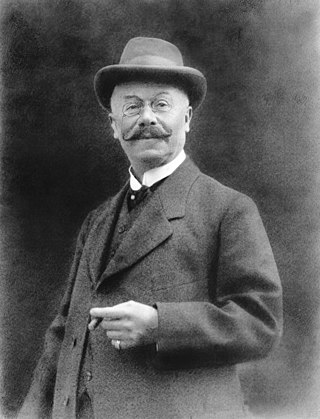
Emil Jellinek, known after 1903 as Emil Jellinek-Mercedes, was an automobile entrepreneur of the Daimler Motoren Gesellschaft (DMG), responsible in 1900 for commissioning the first modern automobile, the Mercedes 35hp. Jellinek created the Mercedes trademark in 1902, naming it in honor of his daughter, Mercédès Jellinek.

In automotive design, an RMR, or rear mid-engine, rear-wheel-drive layout is one in which the rear wheels are driven by an engine placed with its center of gravity in front of the rear axle, and thus right behind the passenger compartment. Nowadays more frequently called 'RMR', to acknowledge that certain sporty or performance focused front-engined cars are also "mid-engined", by having the main engine mass behind the front axle, RMR layout cars were previously just called MR, or mid-engine, rear-wheel-drive layout), because the nuance between distinctly front-engined vs. front mid-engined cars often remained undiscussed.

The Mercedes 35 HP was a radical early car model designed in 1901 by Wilhelm Maybach and Paul Daimler, for Emil Jellinek. Produced in Stuttgart, Germany, by Daimler-Motoren-Gesellschaft (DMG), it began the Mercedes line of cars. Its name is derived from the power of the engine, 35 Pferdestärken(26 kW, approximately 35 horsepower).

The Mercedes-Benz W196 was a Formula One racing car produced by Mercedes-Benz for the 1954 and 1955 F1 seasons. Successor to the W194, in the hands of Juan Manuel Fangio and Stirling Moss it won 9 of 12 races entered and captured the only two world championships in which it competed.
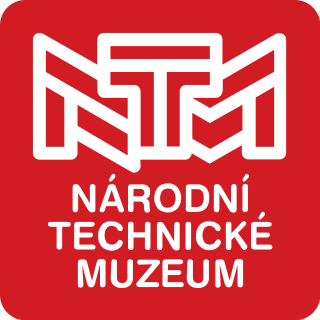
The National Technical Museum (NTM) in Prague is the largest institution dedicated to preserving information and artifacts related to the history of technology in the Czech Republic. The museum has large exhibits representing approximately 15% of its total collection. The museum also manages substantial archives consisting of approximately 3,500 linear shelf meters of archival material and about 250,000 books. The museum was founded in 1908 and has been in its current location since 1941.
Formula Rolon, also known as Formula Rolon Chevrolet and later Formula Rolon 2010 is an open wheel single seater Formula Racing car made and raced in India. They run in the single make championships held in the tracks of Coimbatore and Chennai. The car is similar to Formula Asia, and was powered by 1600cc Chevrolet and later Suzuki engines with a racing gear box. The car was launched in Mumbai December 2005 and made its debut in Coimbatore track in September 2006. The 2010 season was its last season as LG Sports announced that it will not enter Formula Rolon for the 2011 season.

The Tatra 87 (T87) is a car built by Czechoslovak manufacturer Tatra. It was powered by a rear-mounted 2.9-litre air-cooled 90-degree overhead cam V8 engine that produced 85 horsepower and could drive the car at nearly 100 mph (160 km/h). It is ranked among the fastest production cars of its time. Competing cars in this class, however, used engines with almost twice the displacement, and with fuel consumption of 20 liters per 100 km. Thanks to its aerodynamic shape, the Tatra 87 had a consumption of just 12.5 litres per 100 km. After the war between 1950 and 1953, T87s were fitted with more-modern 2.5-litre V8 T603 engines.
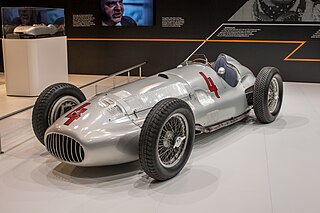
The Mercedes-Benz W154 was a Grand Prix racing car designed by Rudolf Uhlenhaut. The W154 competed in the 1938 and 1939 Grand Prix seasons and was used by Rudolf Caracciola to win the 1938 European Championship.

The Tatra 603 is a large rear-engined luxury car which was produced by the Czechoslovak company Tatra from 1956 to 1975. It was a continuation of the series of Tatra streamlined sedans which began with the Tatra 77. In Socialist Czechoslovakia, only high-ranking party officials and heads of factories were driven in 603s; the car was also exported to a number of other countries.

Mercedes is a brand originally created by the Daimler-Motoren-Gesellschaft (DMG) and used for first time in the 35 hp model released by the company in 1901. DMG began to develop in 1900, after the death of its co-founder, Gottlieb Daimler. Although the name was not lodged as a trade name until 23 June 1902 and not registered legally until 26 September, the brand name eventually would be applied to an automobile model built by Wilhelm Maybach to specifications by Emil Jellinek. This vehicle was delivered to him on 22 December 1900.

The Tatra 30 is an automobile formerly made by the Czech manufacturer Tatra. It was manufactured between 1926 and 1928. From 1928 to 1931 the car was fitted with a newer engine and is therefore called the Tatra 30/52.

The Tatra 12 is an automobile produced by Czech manufacturer Tatra between between 1926 and 1933. It was replaced by the Tatra 57 in 1932.

The Präsident was an automobile manufactured by Nesselsdorfer Wagenbau-Fabriks-Gesellschaft A.G. in 1897. It was the first actually drivable factory made petrol-engined automobile produced in Austria-Hungary as well as in Central and Eastern Europe. It was constructed by Leopold Sviták and Hans Ledwinka. The automobile was more of a carriage without horses than a car in modern sense. The car is steered via handlebars. The wooden bodywork is placed on an iron frame. It has four seats and a convertible top that would cover only the rear seats. Both axles have suspension of semi-elliptical leaf springs. The wheels were similar to the ones of a horse carriage, but had rubber tyres. The car had a two cylinder spark ignition Benz engine placed by the rear axle.
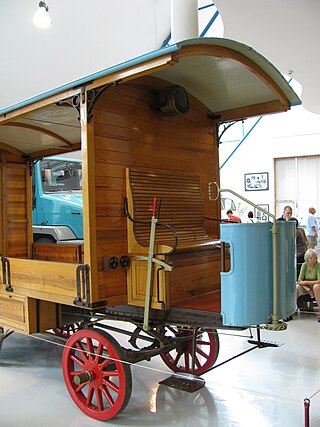
Nesselsdorfer Wagenbau-Fabriks-Gesellschaft (NW) First Truck is an antique truck manufactured by Nesselsdorfer Wagenbau-Fabriks-Gesellschaft A.G. in 1899. A unique feature of the engine setup was that the two engines could be operated sequentially depending on the load requirements. After the company finished its first passenger car, named the Präsident, it focused on manufacturing a truck. The First Truck represents the beginning of the long tradition of Tatra commercial vehicles.

The Nesselsdorf type B is a veteran automobile manufactured by Nesselsdorfer Wagenbau-Fabriks-Gesellschaft A.G.. Initially two cars were made under name Neuer Vierer in year 1901, but later the same car was manufactured under the name type B in 1902 - 1904. In 1904 also another variant of the design was made.
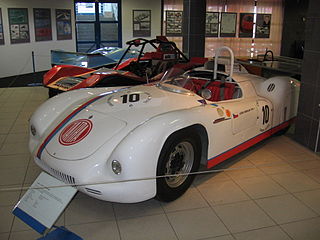
The Tatra 602 Tatraplan Sport is a racing car produced by Tatra in 1949.

The Cooper T39, nicknamed the "Bob-Tail", is a successful lightweight, mid-engined, sports car, designed and developed by Owen Maddock at Cooper Cars, for sports car racing in 1955. The car debuted in active racing competition at the Easter race in Thruxton in 1955, being driven by Ivor Bueb, and was later entered into the 1955 24 Hours of Le Mans, being driven by John Brown and Edgar Wadsworth, but was unfortunately not classified, because even though the car managed to complete 207 laps around the 8.4-mile Le Mans circuit, it didn't manage to finish within 70% of the winners' race distance. However, between 1956 and 1962, it did manage to rack up and tally an incredible streak of domination and competitiveness, scoring 91 total wins and clinching 236 podiums finishes; an incredible record. It was powered by the 1,098 cc (67.0 cu in) Coventry-Climax four-cylinder engine.
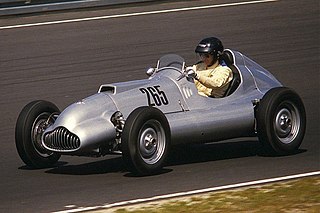
The Veritas Meteor was a Formula One and Formula 2 race car that raced for Veritas and private stables from 1951 until 1954.





















